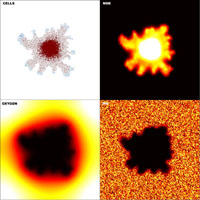
Award for groundbreaking cancer research techniques

Potentially groundbreaking techniques to predict how cancer tumours grow in the body are
currently being developed by an international team which includes Dr Sandy Anderson, a mathematical
biologist from the University's division of mathematics. Their research is considered so
significant that it has been awarded a $15m research grant from the National Cancer Institute.
The award, which came from the National Cancer Institute's (NCI) integrative cancer biology
programme, will be shared between Dundee and Vanderbilt University in the USA, with $750,000 coming
to the University.
The NCI is part of the National Institute for Health, which only grants funding internationally if
the work cannot be carried out within the USA. NCI is funding Sandy's research into the
construction of mathematical models that show how cancers spread. He will be working closely with
Professor Vito Quaranta at Vanderbilt who will be investigating the characteristics of cells,
and how they migrate, invade and interact with one another. Vito's findings will then be used to
build up the mathematical model.
Surgeons will be able to use simulations of these models to help them remove the tumour mass more
accurately. The simulations will increase the likelihood of all of the cancer being removed by
showing the spread of a tumour right down to single cells, too small to be detected by present
imaging techniques.
Uniquely, Sandy's model has the ability to include detailed information about how individual tumour
cells interact with one another and the surrounding tissue so it can predict not only the growth of
the primary tumour but also the potential for the growth of secondary tumours.
Sandy explained, "Currently surgeons take information from scans and use their own knowledge before
they cut out a tumour. They see the cancer mass from the scan, then maybe add a centimetre or two
around what they see, and that is removed. But because the scans can see only the main tumour mass
and not individual cells, that doesn't guarantee the cancer's complete removal. Each cancer cell
that is left has the potential to come back as a new tumour. This technology will give surgeons a
more methodical way of estimating the true tumour boundary and therefore allow much more accurate
removal of the tumour."
Vito said, "In the next 10 to 20 years our doctors should be able to tell by using a computer
programme whether the cancer will become invasive or not. It's a very exciting development." Sandy
and Vito will hold meetings regularly via web cam as well as making visits to their respective
labs.
Next Page
Return to April 2005 Contact

